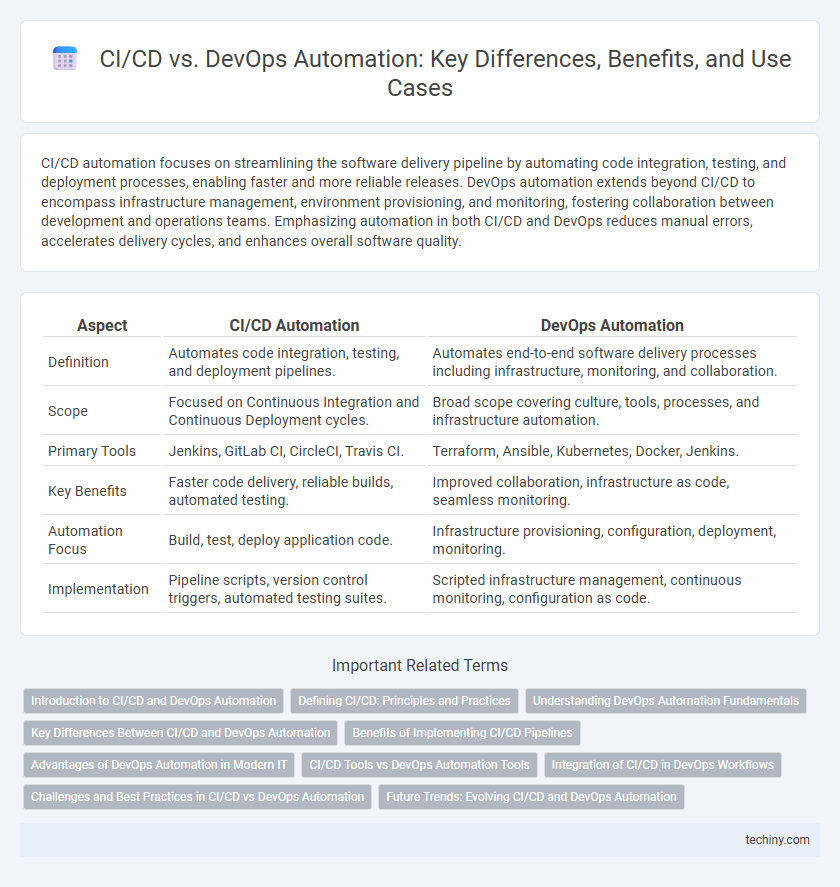CI/CD automation focuses on streamlining the software delivery pipeline by automating code integration, testing, and deployment processes, enabling faster and more reliable releases. DevOps automation extends beyond CI/CD to encompass infrastructure management, environment provisioning, and monitoring, fostering collaboration between development and operations teams. Emphasizing automation in both CI/CD and DevOps reduces manual errors, accelerates delivery cycles, and enhances overall software quality.
Table of Comparison
| Aspect | CI/CD Automation | DevOps Automation |
|---|---|---|
| Definition | Automates code integration, testing, and deployment pipelines. | Automates end-to-end software delivery processes including infrastructure, monitoring, and collaboration. |
| Scope | Focused on Continuous Integration and Continuous Deployment cycles. | Broad scope covering culture, tools, processes, and infrastructure automation. |
| Primary Tools | Jenkins, GitLab CI, CircleCI, Travis CI. | Terraform, Ansible, Kubernetes, Docker, Jenkins. |
| Key Benefits | Faster code delivery, reliable builds, automated testing. | Improved collaboration, infrastructure as code, seamless monitoring. |
| Automation Focus | Build, test, deploy application code. | Infrastructure provisioning, configuration, deployment, monitoring. |
| Implementation | Pipeline scripts, version control triggers, automated testing suites. | Scripted infrastructure management, continuous monitoring, configuration as code. |
Introduction to CI/CD and DevOps Automation
CI/CD (Continuous Integration and Continuous Deployment) automates the process of code integration, testing, and deployment, enabling faster and more reliable software delivery. DevOps Automation encompasses a broader scope, integrating CI/CD pipelines with infrastructure management, monitoring, and collaboration tools to streamline the entire software development lifecycle. Emphasizing automation in both CI/CD and DevOps reduces manual errors, accelerates release cycles, and enhances operational efficiency in modern software engineering environments.
Defining CI/CD: Principles and Practices
CI/CD (Continuous Integration and Continuous Delivery) is a software development practice that automates code integration, testing, and deployment to ensure rapid and reliable releases. Core principles include frequent code commits, automated testing, and seamless delivery pipelines that minimize human error and accelerate feedback loops. Implementing CI/CD reduces integration challenges by maintaining consistent build quality and enabling faster iteration within DevOps frameworks.
Understanding DevOps Automation Fundamentals
DevOps automation integrates continuous integration and continuous delivery (CI/CD) pipelines with infrastructure management to streamline software development and deployment processes. It automates repetitive tasks such as code integration, testing, deployment, and monitoring, enhancing collaboration between development and operations teams. Understanding DevOps automation fundamentals involves mastering tools like Jenkins, Kubernetes, Docker, and Ansible to achieve faster release cycles and improved software quality.
Key Differences Between CI/CD and DevOps Automation
CI/CD focuses on automating the software development lifecycle stages such as code integration, testing, and deployment to ensure continuous delivery and integration. DevOps Automation encompasses a broader scope including infrastructure provisioning, configuration management, monitoring, and collaboration between development and operations teams to streamline the entire application lifecycle. Key differences lie in CI/CD's specific pipeline automation versus DevOps Automation's comprehensive approach to both development and operational workflow enhancements.
Benefits of Implementing CI/CD Pipelines
Implementing CI/CD pipelines significantly reduces software delivery time by automating code integration, testing, and deployment processes, ensuring faster and more reliable releases. Continuous feedback loops and automated testing minimize human errors and improve code quality, leading to enhanced product stability. This automation accelerates innovation cycles and optimizes resource utilization, making CI/CD a critical component in modern DevOps strategies.
Advantages of DevOps Automation in Modern IT
DevOps automation integrates continuous integration, continuous delivery, and infrastructure automation to accelerate software development and deployment cycles while enhancing collaboration between development and operations teams. It reduces manual errors, increases deployment frequency, and improves system reliability by automating repetitive tasks and enabling real-time monitoring. Modern IT organizations adopting DevOps automation benefit from faster time-to-market, scalable infrastructure management, and enhanced ability to respond to business needs swiftly.
CI/CD Tools vs DevOps Automation Tools
CI/CD tools like Jenkins, GitLab CI, and CircleCI specialize in streamlining code integration, automated testing, and deployment pipelines, enhancing software delivery speed and reliability. DevOps automation tools, including Ansible, Puppet, and Terraform, extend automation to infrastructure management, configuration, and environment provisioning, enabling comprehensive operational workflows. Integrating CI/CD tools with DevOps automation platforms ensures seamless collaboration between development and operations, driving continuous delivery and infrastructure as code practices.
Integration of CI/CD in DevOps Workflows
CI/CD integration in DevOps workflows streamlines software delivery by automating code integration, testing, and deployment within continuous cycles. This automation enhances collaboration between development and operations teams, accelerates feedback loops, and reduces the risk of human error during releases. Implementing robust CI/CD pipelines ensures consistent, faster delivery of high-quality applications aligned with DevOps principles.
Challenges and Best Practices in CI/CD vs DevOps Automation
CI/CD automation faces challenges such as integration complexity, frequent pipeline failures, and maintaining test coverage consistency, requiring best practices like modular pipeline design and continuous feedback loops. DevOps automation encounters obstacles in toolchain integration, cultural alignment, and managing infrastructure as code, emphasizing best practices like version control, automated configuration management, and cross-functional collaboration. Prioritizing robust monitoring, scalability, and security ensures effective automation strategies across both CI/CD and DevOps workflows.
Future Trends: Evolving CI/CD and DevOps Automation
Future trends in CI/CD and DevOps automation emphasize increased integration of AI and machine learning to optimize pipeline efficiency and predict potential failures before deployment. Cloud-native technologies and microservices architectures facilitate more scalable and flexible automation workflows, enabling continuous delivery at unprecedented speeds. Enhanced security automation and compliance monitoring are becoming critical as organizations prioritize risk mitigation throughout the software development lifecycle.
CI/CD vs DevOps Automation Infographic

 techiny.com
techiny.com